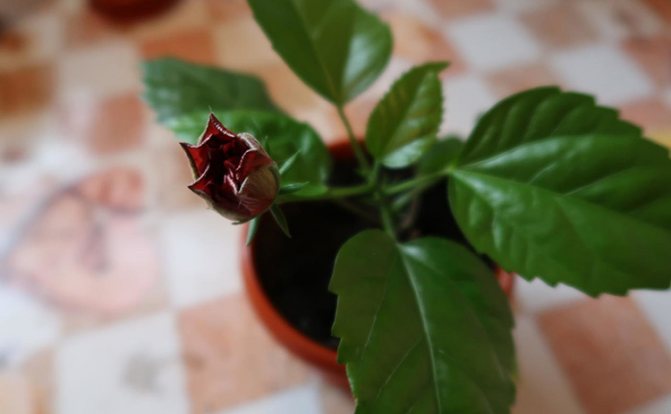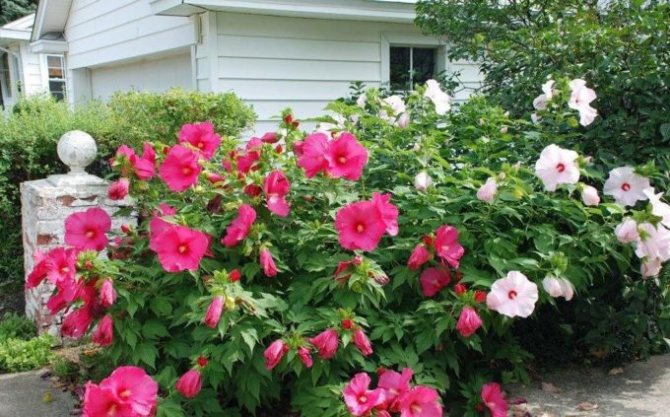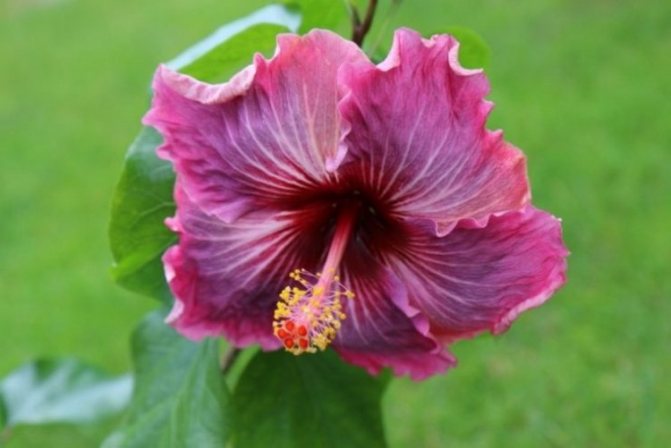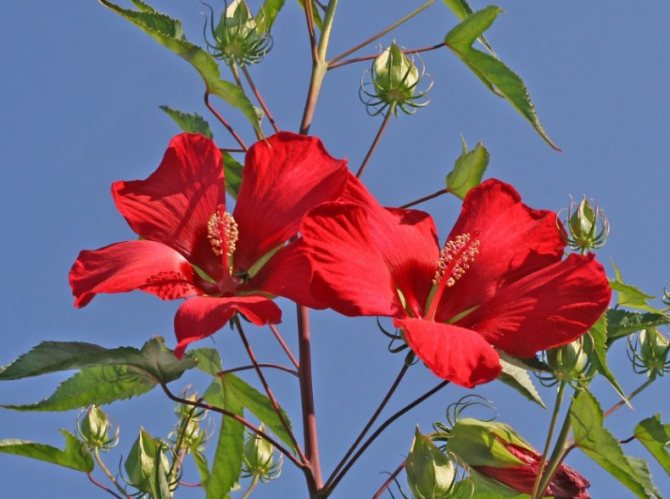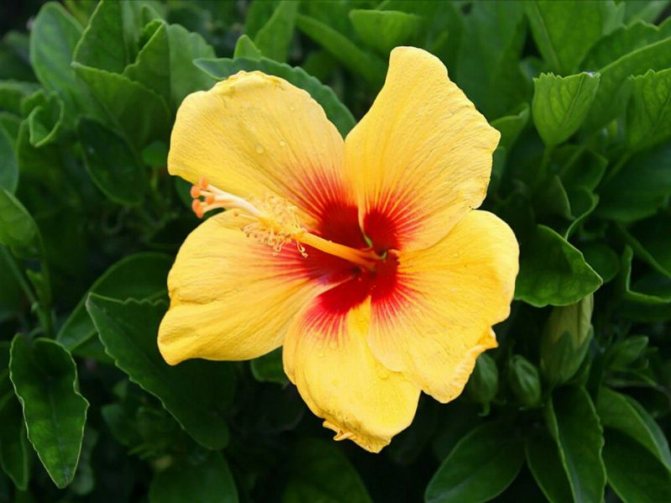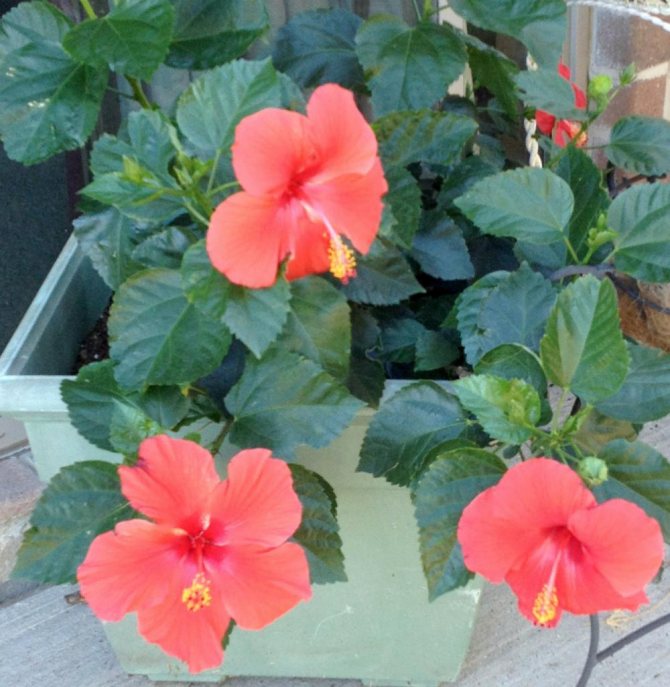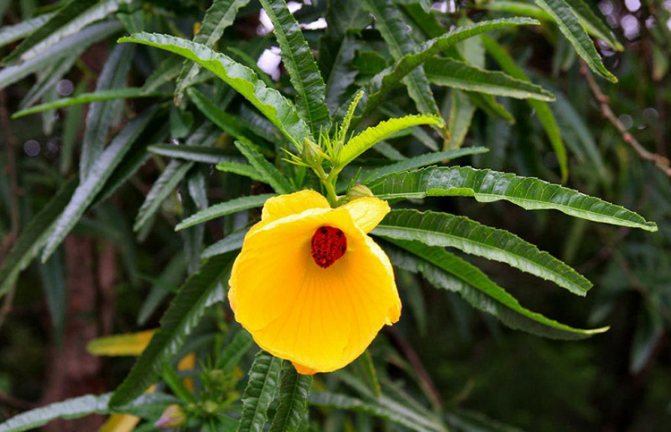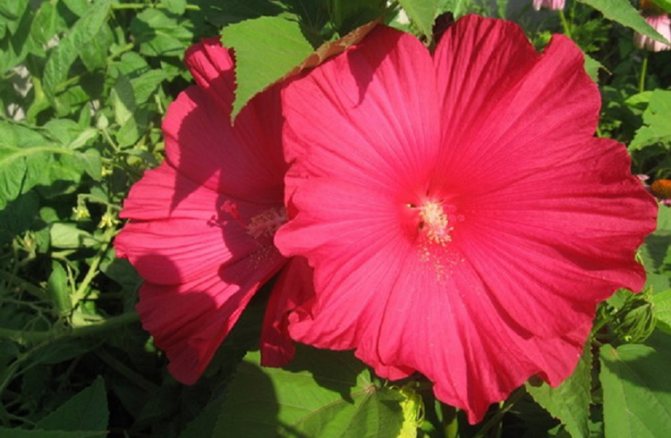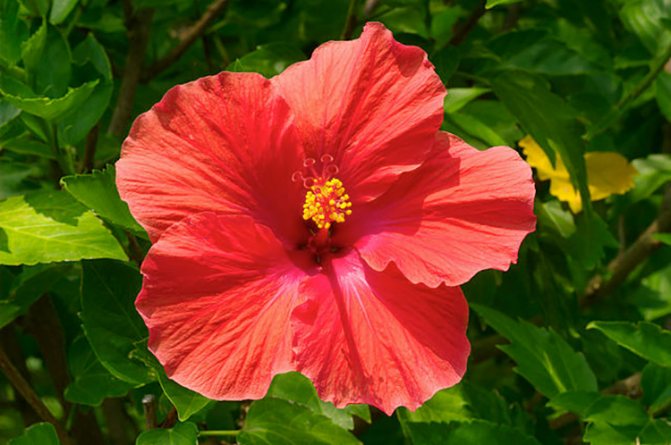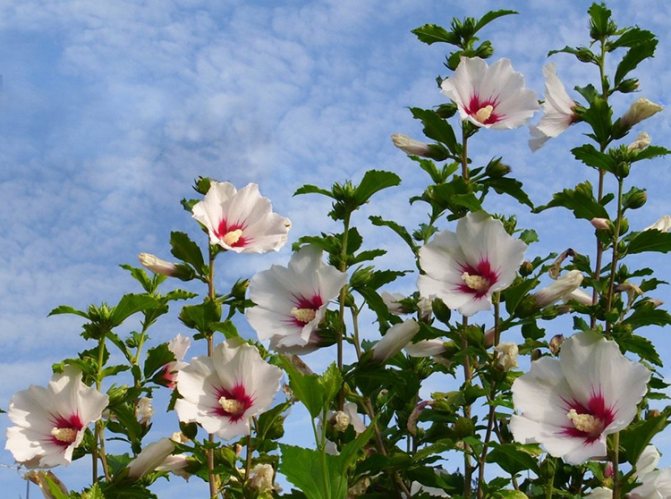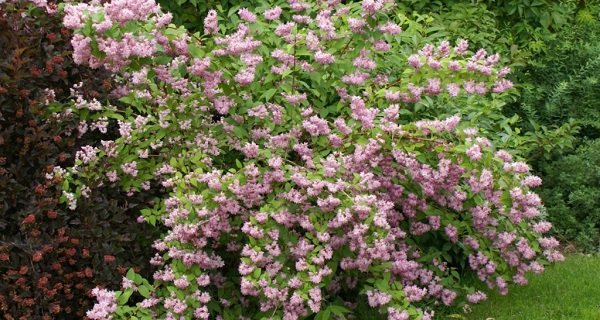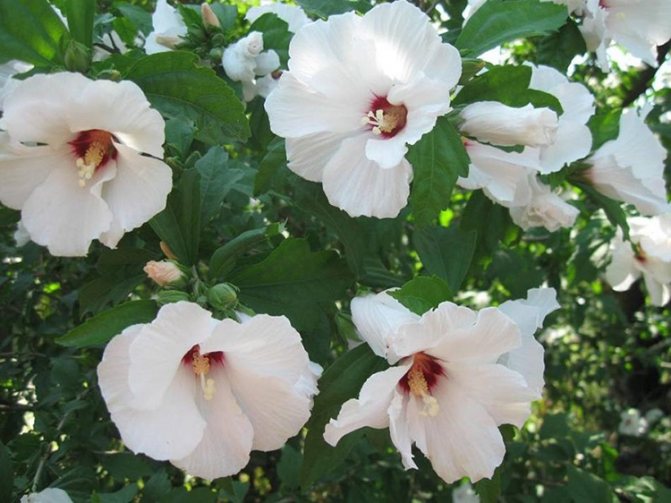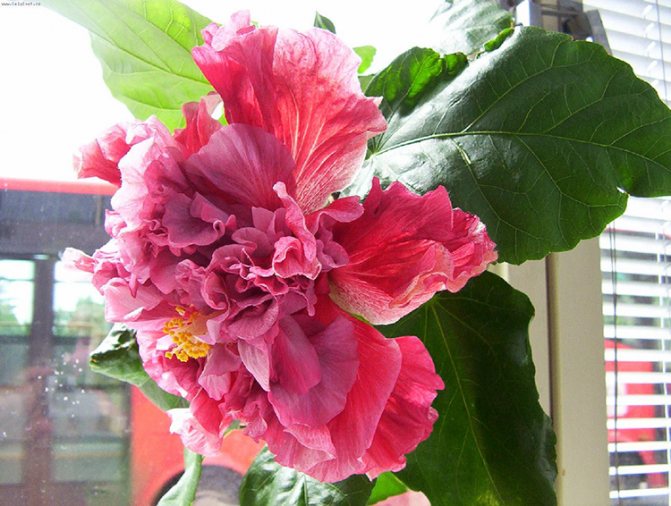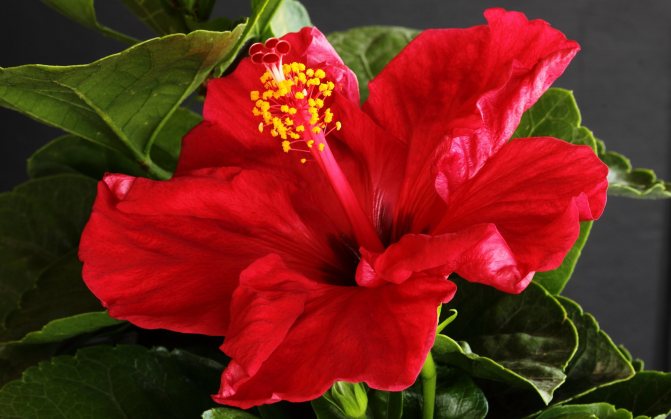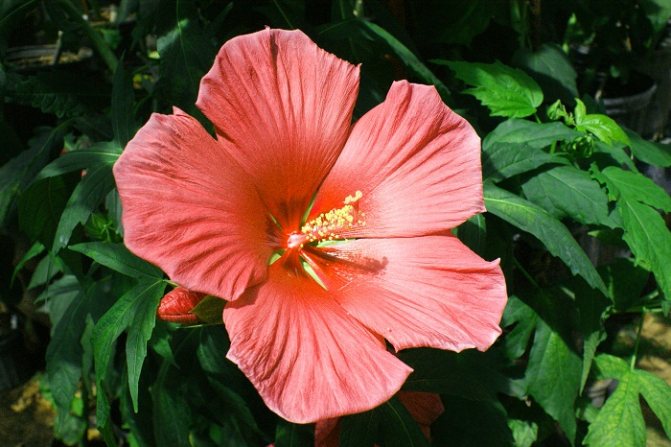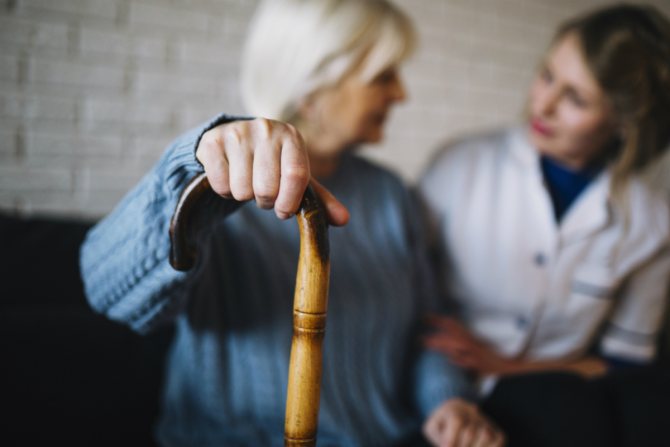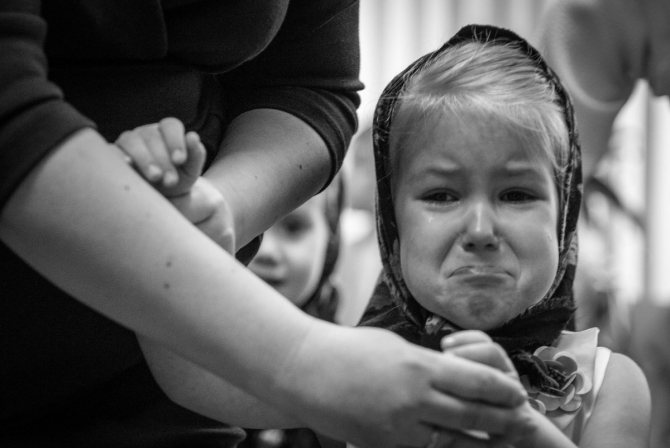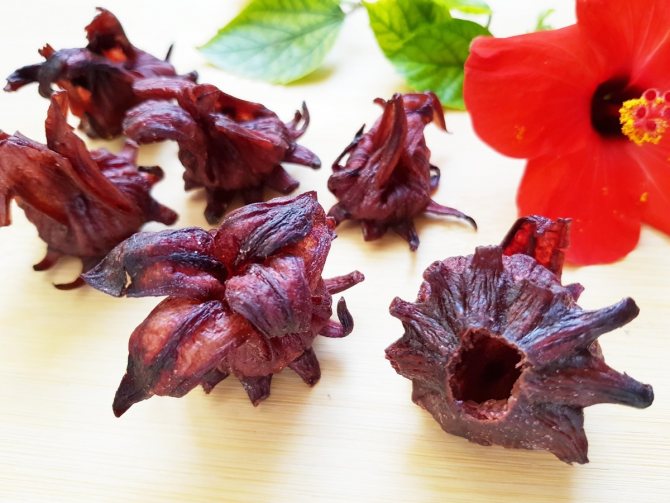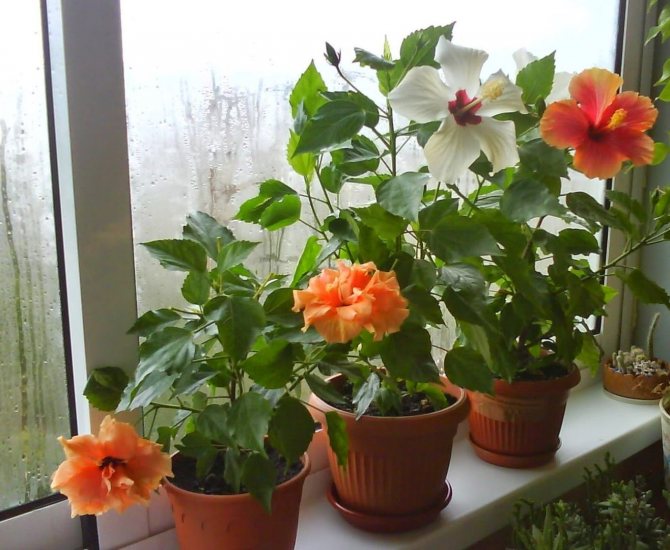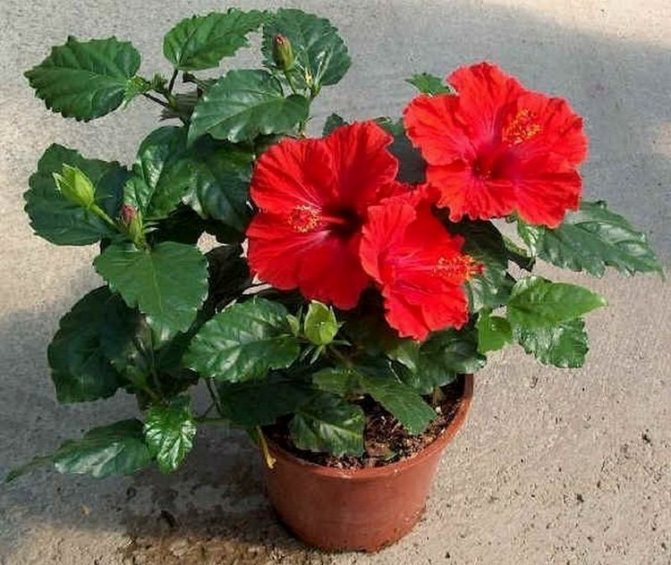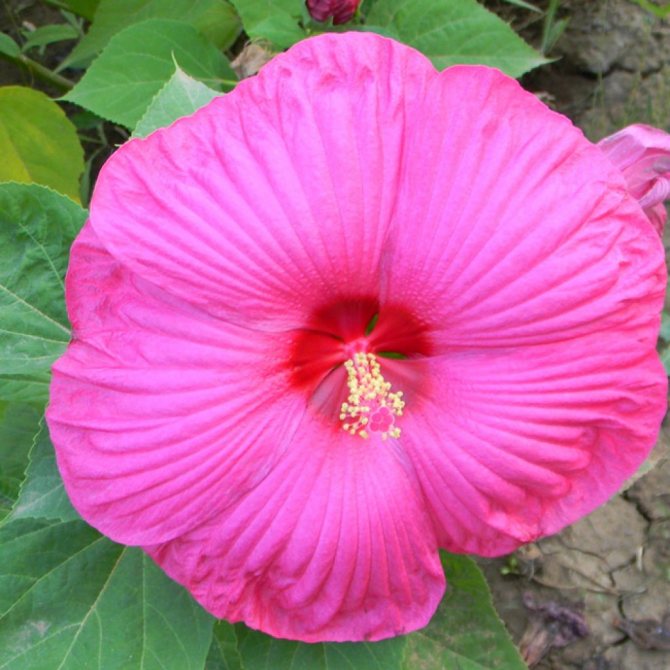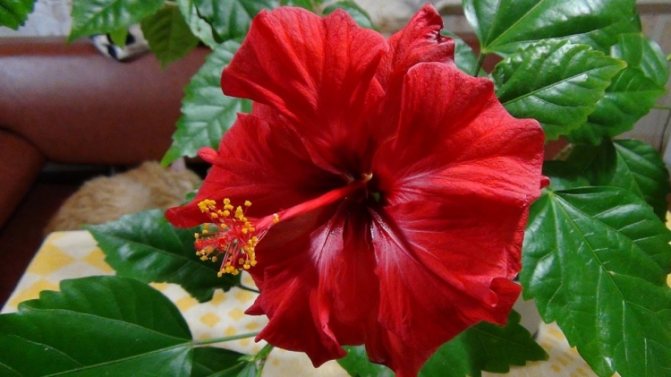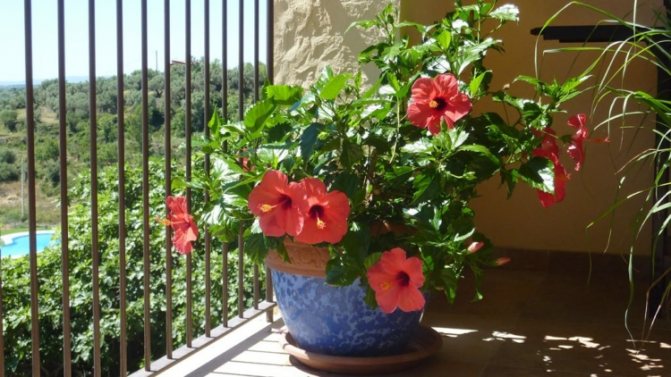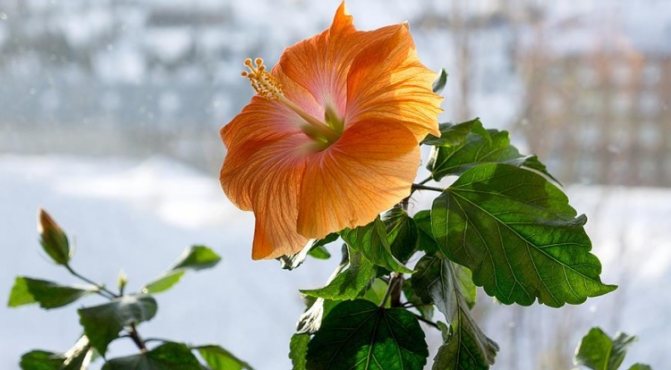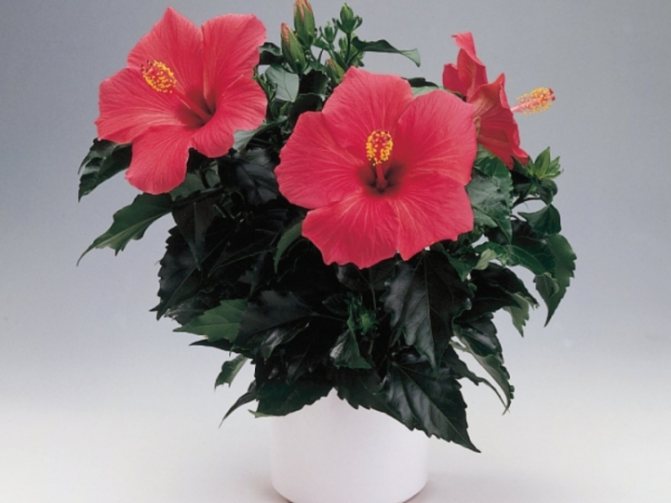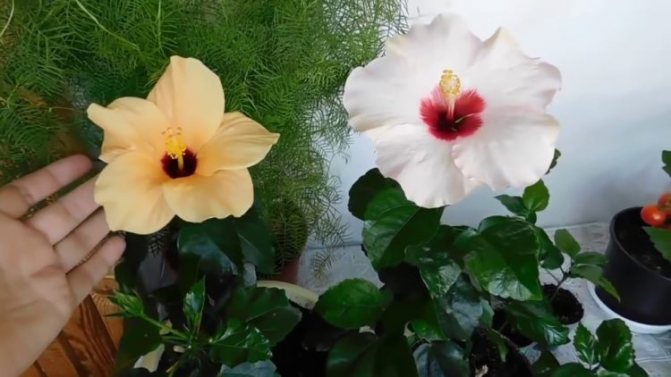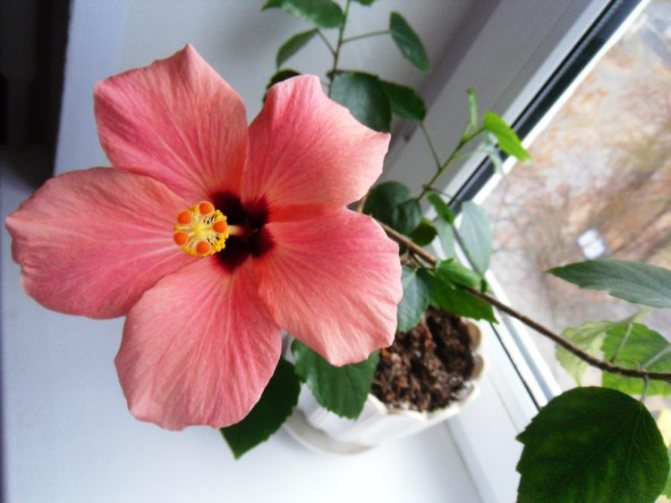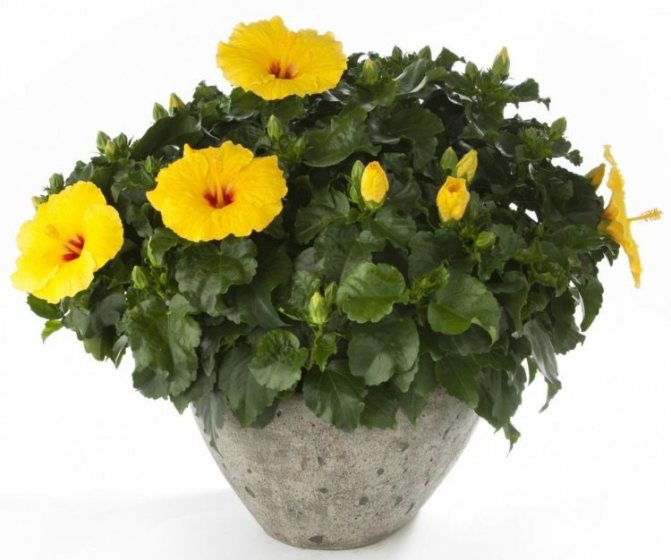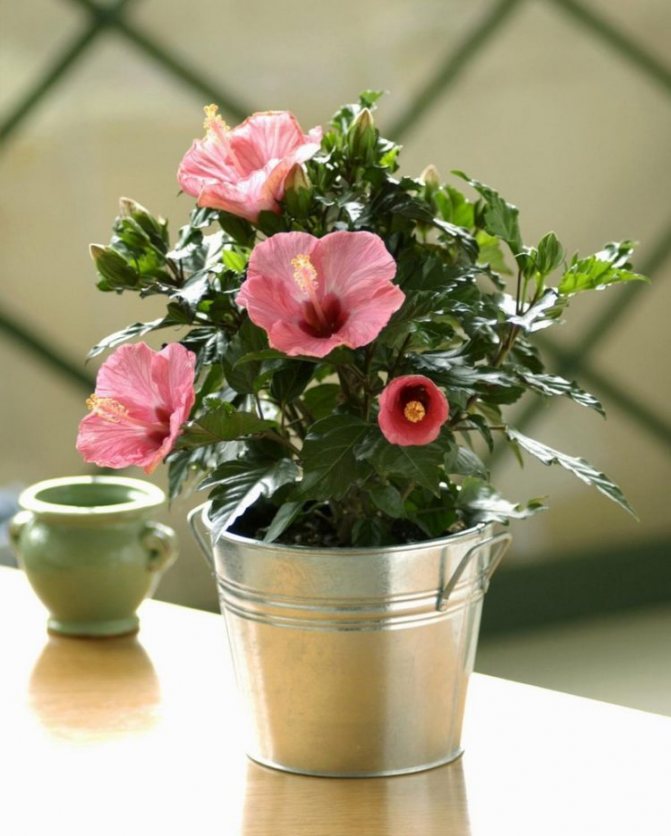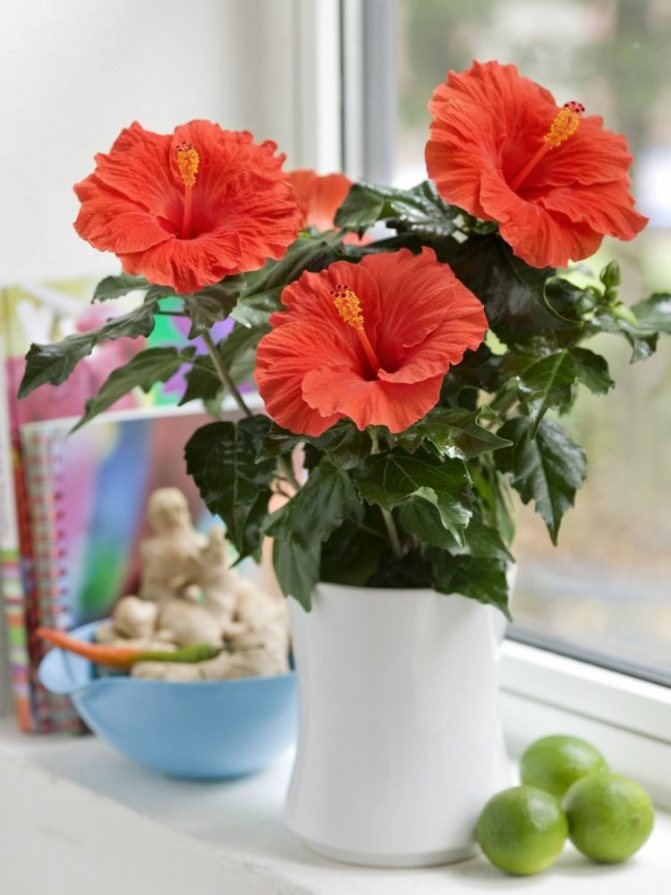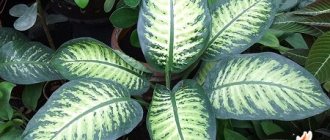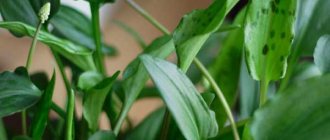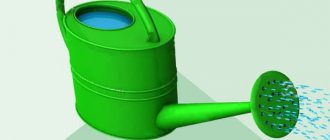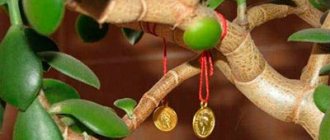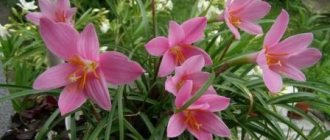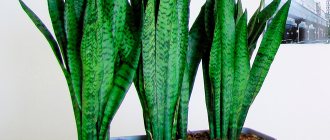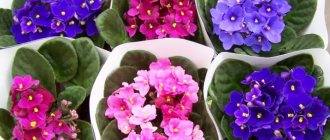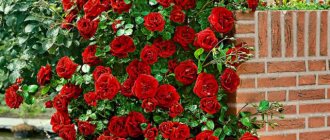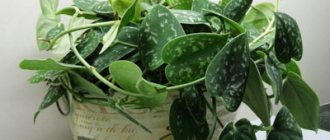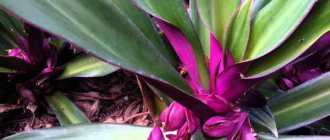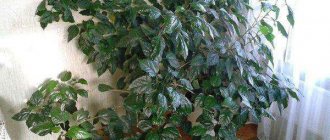The Chinese rose, or hibiscus, has received a not very pleasant nickname among the people. This plant is called the flower of death, and superstitious people attribute various mystical properties to it. But he does not always bring trouble to the house - some signs about the Chinese rose have a positive interpretation and portend a favorable turn of fate.
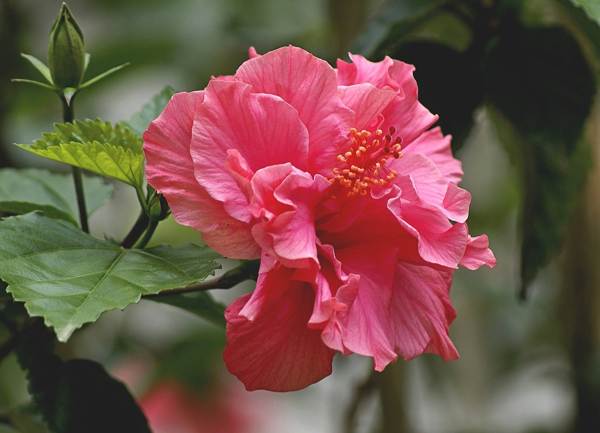
Description and origin of the plant
Hibiscus belongs to the malvaceous family... About 300 species of this plant are known, which can be absolutely different from each other and differ both in the shape and color of the inflorescences, and in the appearance of the foliage. As the name suggests, the homeland of hibiscus is China, but this is not entirely accurate, since it is also widespread in South and West Asia, on the Polynesian islands and in other areas with a hot tropical climate.
This flower can grow in the form of a grass, shrub, subshrub, even a tree. The most famous and common types of Chinese rose are the Syrian hibiscus, trifoliate and Drummond.
Garden hibiscus is considered the most cultivated and adapted to life in an apartment. This indoor flower grows in the form of a tree and can reach a height of up to 3 m. It has rather large dark green oblong leaves with jagged edges. The graceful flowers of hibiscus often grow to a very large size, some of which can reach the size of a soccer ball.
The colors are also very diverse, flowers can be either one-color or combine several shades. The most common color is bright red, which superstitious people compare to blood and pain.
The stock rose can bloom almost all year round from March to November. It happens that the flowering period even extends until the beginning of winter. Some well-known prejudices associate the extraordinary flowering of hibiscus with a bad omen and call the Chinese rose the flower of death, which is why the cultivation of this plant has become so undesirable in the apartments of modern people.
Description of species
Garden hibiscus flower
Breeders have adapted the current garden hibiscus to temperate climates since the 50s of the twentieth century. The herbaceous hybrid hibiscus has large one-day flowers, up to 20-25 cm in diameter.
Formed at the tops of the shoots. The stems are light green, strong, the bush spreads up to 60-90 cm. From a distance it can look like a stock-rose with huge petals. Blooms profusely from July to autumn. The plant is light-requiring. Before frosts, shoots are cut off the ground, the base is mulched.
The garden type, which is called Syrian, as it was created on its basis, blooms, creating buds around the entire perimeter of the bush, which reaches up to 1.3-1.8 m in width. Single flowers, simple and double, with a diameter of 9-12 cm, are formed densely, different varieties have their own shades. There are vibrant two-tone petal combinations. With proper pruning, the flowers are large and plentiful every year. Without this procedure, they become noticeably smaller. The shrub is moisture - and photophilous.
A type of hibiscus with a different name - the Chinese rose, is grown indoors. The home flower is also unpretentious, growing up to 0.8-2 m. The main requirements in its agricultural technology are a bright place, warmth and high air humidity. The buds open simple and double, bloom from April to October.
In Russia, varieties with scarlet petals are more common, although collectors have plants with various colors. It is about this species that unjustified and unsubstantiated doubts arise: hibiscus, is it possible to keep such a flower at home? Lovers grow it and do not get rid of living decoration and natural air purifier, do not remove it from apartments.
Bad omens
No one knows exactly who and when attributed such a bad name to the beautiful flower. Knowing the people and circumstances that call hibiscus the garden flower of death and why, could dot the i's and change the negative attitude of people towards the stock-rose. It is possible that at one time someone had several deaths of loved ones, they were associated with the presence of hibiscus in the house, and since then there has been such an unsightly opinion. The main bad omens include the following:
- If a rose bloomed outside of school hours, in the near future, the death of one of the household members will occur. This can only be avoided by burning the unfortunate plant.
- You can not keep a hibiscus at home due to the fact that it is a vampire or burnet (perhaps so it was named because of its large blood-red flowers) and sucks out all vitality and energy from the owner, inducing illness and subsequent death on him. And after the death of a person, the stock-rose begins to bloom even more magnificently and more due to the life of the owner received.
- It is believed that if the plant begins to shed or dry its leaves, then soon one of the owners or their loved ones will get sick with a serious illness. In this case, all household members urgently need to undergo a medical examination.
- In addition to the nicknames "vampire" and "burnet", hibiscus is called muzhegon. This means that if a girl is unmarried, she will attract the attention of a male, but no one will stay in her house for a long time. And if a man already lives in the apartment, then soon he will leave this place of his residence. And a woman or a girl is doomed to loneliness as long as this plant exists in their house.
- The appearance of hibiscus in a house where peace and harmony reigned will mark the beginning of quarrels and strife, which will not end well for the owners of the rose.
Knowing about all these signs, many people are sure that you can't keep hibiscus at home... Some owners even report a deterioration in well-being due to this plant. But perhaps, if they did not know about such superstitions, they would feel good. That is, simple self-hypnosis can take place here.
It is also believed that hibiscus grows remarkably in hospitals, feeding on the energy of patients. But good growth and abundant flowering is actually due to the fact that the corridors of medical facilities are well ventilated and have adequate lighting, providing ideal conditions for flower development.
Where to grow hibiscus
Lovers of beautiful Chinese rose flowers are advised to grow the plant in the corridor or hallway, as well as on the balcony and terrace.
The flower is not suitable for a nursery, but this has nothing to do with bad omens. When blooming, pollen is abundantly released, which can cause allergic reactions in a child.
You should not believe in all the legends and take them to heart. Especially those where it is said that the flower bloomed at the wrong time or the leaves began to fall off rapidly, which leads to illness or death of loved ones. It is a natural life process in all plants and cannot be reversed.
Useful properties of hibiscus
In addition to various signs and superstitions, hibiscus has many useful qualities for human health. Moreover, they are all proven by science and are widely used in medicine and in everyday life. Among them are the following:
- In many oriental dishes, crushed and dried hibiscus flowers are used as a flavorful condiment.It is also customary to add them to coffee in order to increase appetite.
- The plant is capable of emitting phytoncides into the atmosphere, which are an excellent prevention of viral diseases.
- Aromatic oils from hibiscus are used to treat colds in the upper respiratory tract.
- Fragrant hibiscus tea is prepared from the petals of the stock rose, which has a beneficial effect on the entire human body, rejuvenating it and giving it strength. In cold form, this drink is able to lower blood pressure, in warm form - on the contrary, to increase. Such tea is actively used for weight loss diets.
- Decoctions from hibiscus petals are rich in vitamin C, can increase immunity, tone up, remove toxins from the body and have a beneficial effect on the organs of vision.
Can I grow in an apartment?
Hibiscus flowers contain many beneficial substances (read more about beneficial and harmful properties here):
- acids - malic, tartaric, ascorbic and citric;
- anthocyanins and flavonoids;
- polysaccharides and pectins;
- gamma-linoleic acid, which dissolves fatty plaques and actively fights cholesterol deposits in the vessels.
Flowers are used in the form of gruel, decoctions, infusions, but basically they just brew dried petals like tea. Hibiscus tea is capable of:
- Clean the vessels.
- Reduce pressure.
- It has a pronounced diuretic properties.
- Tones up.
- Cleans the body of pathogenic bacteria.
Gruel of leaves and stems is used to treat acne, inflammation, abscesses.
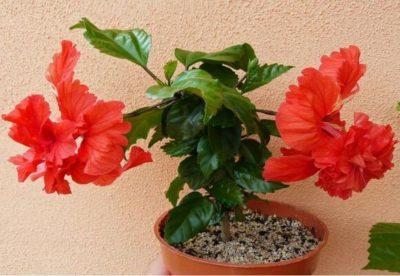

Hibiscus is also used in aromatherapy, its smell is sweetish, extremely pleasant, soothing. It is believed that the flower secretes special substances that increase libido, and it is often bought by couples who want to have children in the near future.
Home-grown Chinese rose, with regular watering, enriches the air in the room with phytoncides and actively humidifies it. Humid air contains much less dust. Plants such as hibiscus reduce the risk of developing colds in winter several times and contribute to the healing of the whole body. A feature of the flower is its ability to absorb and decompose trichlorethylene, which is a part of furniture varnishes and is considered a carcinogen.
Care and cultivation of hibiscus
Sooner or later, every breeder is eager to get a Chinese rose flower. But is it possible to keep him at home, knowing about the terrible signs? In fact, each person makes a choice for himself whether to believe or not to believe such prejudices. In addition, this plant is really very beautiful and at the same time quite unpretentious. And this is another of its big advantages. To keep hibiscus in the house, it is enough to observe the following care conditions:
- The plant is very light-requiring. To obtain abundant growth and flowering, you need to provide it with a lot of light, if necessary, supplement it.
- Watering should be abundant during the hot summer months. In winter, it needs to be cut.
- A young rose needs to be replanted and pruned every year to get more shoots. An adult plant needs replanting every 3 years.
- The soil should be composed of a mixture of sod and leafy soil mixed with sand.
- If the flower begins to lose leaves, this may indicate that it lacks moisture.
- Falling buds mean that the room temperature is not suitable for the hibiscus or it has gone through a sharp change in temperature.
- If yellow or orange spots appear on the lower part of the leaves, this indicates that the plant has become covered with rust, and urgent treatment with a fungicide is required.
- When rolling the leaves, spray the stem rose frequently with warm water to avoid the appearance of aphids or other parasites on it.
Each florist decides for himself whether to believe the omens or not.Or you can simply discard all prejudices and have such a beautiful and spectacular plant in your apartment, which, with proper care, will delight its owners with magnificent bright flowers for a long time.
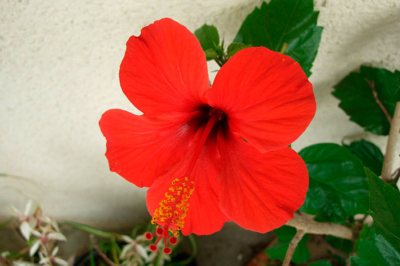

Hibiscus (Chinese rose) is an unusually effective and at the same time unpretentious houseplant in the content.
Bright, large hibiscus flowers can decorate any room, but the blooming Chinese rose looks especially good in large spaces of halls, corridors and reception areas of public buildings.
Care
Hibiscus flower: what kind of plant, a description of how to grow
Water the plant in moderation, make sure that the soil does not dry out. Mulching the trunk circle with crushed bark or perlite will help. Constantly keep the soil slightly damp during dry periods, otherwise the buds will not stick. Sprinkling in the evening will be beneficial.
They are fed from early spring, applying complex fertilizers for flowers, in which the nitrogen content is not less than 16%. In summer, flowers need potassium. In August, September fertilized with potassium-phosphorus preparations. In October, 30-40 liters of water are poured, mulched with humus, spud. In the regions of central Russia, young bushes are later covered with spruce branches or burlap and spunbond.
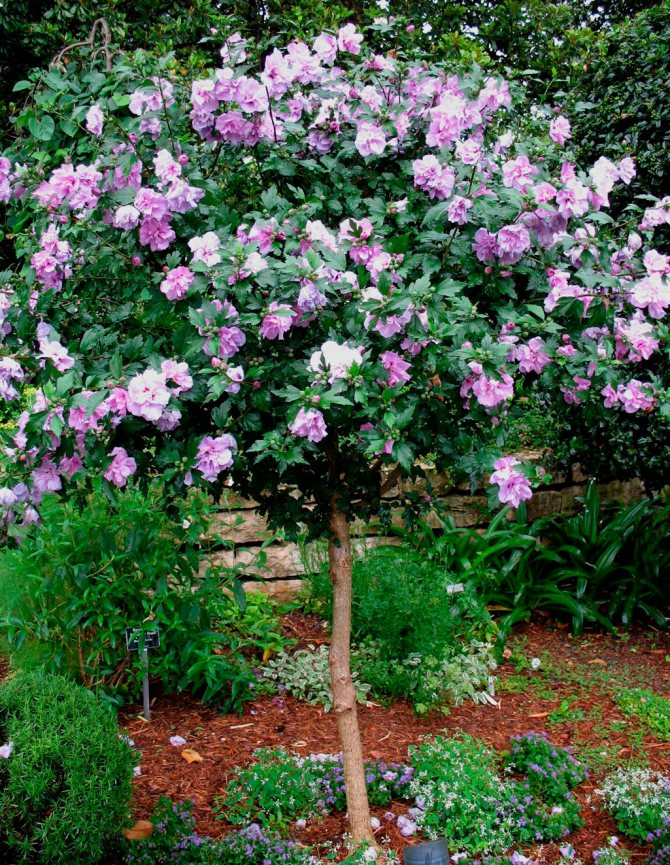

Water the plant moderately
After spring feeding, the hibiscus is cut off. It is necessary to remove the branches that grow inside the bush, and the damaged ones. Young shoots will grow quickly. Then the plant is formed by cutting the branches by 1/3. The bush will become more lush and by the summer it will create large flowers that are formed on the shoots of the current year.
Additional Information. After a possible slight frosting, hibiscus quickly recovers and grows shoots.
Room view care includes:
- regular watering and spraying of the plant;
- organization of a dormant period in winter with temperatures up to 14-16 ° C;
- highlighting a place with bright diffused light.
Description and photo of the plant
The Chinese rose has many varieties, differing in size, color and shape of flowers and leaves, as well as the size of the plant itself. Hibiscus belongs to the Malvaceae family, native to Sri Lanka, China, Indonesia, Fiji and Haiti.
In Russia, the most widespread is the hybrid hibiscus, bred at the beginning of the 20th century by the Soviet scientist Fedor Rusanov. This species has bright scarlet large flowers, the plant itself is medium in size.
Look at the photo of the plant:
Photo
Below you will see a photo of a houseplant:
Chemical composition
Due to its chemical composition hibiscus has become widely used in folk medicine - its flowers contain:
- a large amount of malic, citric and tartaric acid;
- 13 valuable amino acids;
- many polysaccharides, including pectin.
By composition, hibiscus leaves:
- 70% carbohydrates;
- 15% protein;
- 5% fat;
- up to 10% in the total volume of ash, phosphorus and potassium.
Nutritional value of 100 g:
- Proteins: 0.43 g.
- Fat: 0.65 g.
- Carbohydrates: 7.41 g.
- Macronutrients: potassium 9 mg, calcium 1 mg, magnesium 1 mg, phosphorus 3 mg.
- Trace elements: iron 8.64 mg, copper 0.073 mg, zinc 0.12 mg.
What does the flower symbolize
The Chinese rose is ranked among the Malvovs. It has different names: rose Sharon, red sorrel, hibiscus, hibiscus, Venice mallow, okra. The main places where the tropical tree grows:
- China;
- Haiti;
- Fiji;
- Indonesia;
- Java;
- Sri Lanka.
Residents of different countries have different attitudes to mallow.
- Malaysian women weave okra in their hair to show their innocence.
- Hawaiians and Haitians symbolize mallow with beauty. Houses are decorated with a bright flower, they are presented to tourists as a keepsake.
- Melanesians associate hibiscus with wealth.
- Indians weave exotic flowers into wedding wreaths.
- Residents of southern China consider mallow to be an attribute of any wedding.
- Every Argentinian grows at least three types of hibiscus at home.
- In Brazil, the Chinese rose represents fertility. Childless couples put a pot with a bright tree on the windowsill so that they will soon have a child.
But not all cultures associate red sorrel with good omens. For example, Europeans believe that the okra is muzhegon. The tree has a powerful energy that can drive a husband out of the house. According to signs, single women cannot keep hibiscus at home. It is also undesirable for a Chinese rose to stand on the windowsill of a married couple. This can lead to treason.


Fijians in the city of Suva annually hold a festival dedicated to the Chinese rose. The event lasts one week. During the holiday, people arrange parades, dances, and show circus acts. Fijians consider hibiscus a symbol of fire. People believe that the festival is a kind of ritual that allows them to earn the favor of the gods in order to gain prosperity for their country next year.
Beneficial features
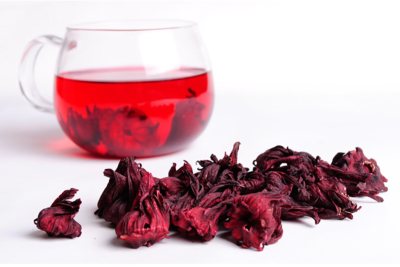

Hibiscus tea, which is made from dried hibiscus leaves, perfectly quenches thirst, has a good effect on digestion, and regulates appetite. It also has an antimicrobial effect, improves the functioning of the pancreas and liver, is able to reduce allergic reactions and even cope with the effects of alcohol poisoning.
It is a kind of natural antidepressant that increases the performance of the brain and the general physical endurance of a person.
Hibiscus flowers are especially useful for people suffering from cardiovascular diseases. Hibiscus tea brilliantly copes with the normalization of blood pressure: hot it increases, cold - lowers. It destroys cholesterol deposits and strengthens the walls of blood vessels.
A decoction of Chinese rose flowers has a mild anthelmintic effect and can be used even by preschool children.
We offer you to watch a video about the beneficial properties of hibiscus tea:
Hibiscus - the flower of love
The scarlet flowers of the Chinese rose are a symbol of passion. In India, they are woven into the wreaths of the bride and groom so that their love ardor is preserved for a long time. But this opinion is held only in Asia.
In Europe, the plant is considered muzhegon. It has a strong energy to "drive" a man out of the house. A woman caring for a hibiscus will have a stormy but fleeting romance. For the same reason, superstitions forbid a married couple to have this flower.
Cosmetic properties of the plant
According to signs, ladies begin to look desirable, their skin glows with health, and their hair becomes silky. But how much of these beliefs is from magic, and how much from home cosmetology?
Hibiscus buds wilt quickly, but even then they can still be beneficial. A decoction is prepared from the dried petals, the regular use of which strengthens health, evens out skin tone, removes rashes and redness from it, and promotes hair growth.
The easiest way to get an infusion is to brew hibiscus tea. When cold, it reduces pressure, removes excess fluid from the body, and when hot, it relieves muscle spasm.
Fresh buds can also be sacrificed for beauty. They make lapping, which are part of creams, perfumes, hair dyes. Malaysians cut down the green shoots of the Chinese rose, making them vitamin salads.
The plant emits substances that disinfect the air, absorbs harmful compounds from the atmosphere. This property has a positive effect on health, improving appearance.
Can I keep it at home?
Hibiscus undoubtedly decorates the interior and its hybrid variety will perfectly fit into any residential or commercial space of the appropriate size.
Is the Chinese rose poisonous or not?
This plant is not poisonous, so you can take care of it without special precautions. It is not recommended for keeping only in the bedrooms of children under 1 year old due to the risk of individual intolerance to this flower.
How does a flower affect the human body?
In addition to its decorative function, the Chinese rose does an excellent job of improving the indoor climate:
- saturates the air with oxygen;
- ionizes, moisturizes it;
- thanks to the secreted phytoncides, it removes viruses and microbes from the air.
All this has a beneficial effect on the health of people present in the room, especially during the heating season.
Indispensable hibiscus for dusty, smoky rooms, because it perfectly retains dust particles on its leaves and cleans the air from tobacco smoke.
Disease and pest control
Both garden and indoor hibiscus are hardy, rarely get sick. When grown, they encounter yellowing and leaf fall. Chlorosis occurs due to a lack of iron and nitrogen. Feeding the plant with iron chelate will help to get rid of the ailment of the plant. After transplantation, the roots are supported with Zircon or Kornevin preparations.
Fin arched summer without watering, the bush suffers from pests:
- The spider mite spoils the leaves by sucking the juice. The symptom is yellow spots. For treatment, the bush is treated with acaricides.
- Thrips lay their eggs in the buds, which fall off. Apply "Confidor", "Fitoverm", "Vertimek".
- The same drugs are used to get rid of aphids, whiteflies, mealybugs.
- Prevention is carried out in early spring, spraying the bush with a mixture of insecticide and fungicide, for example, "Aktara" and "Horus".
Flower in the interior of the apartment
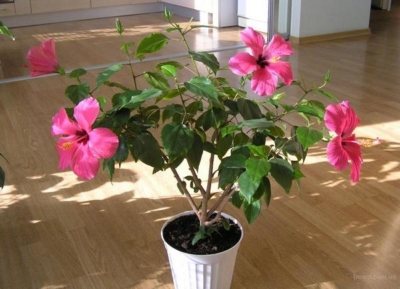

Hibiscus is unpretentious in its content and will fit into almost any interior. Best of all, it will grow in a spacious, brightly lit room without drafts - an ideal option would be a spacious hall, a bright room with a high ceiling.
Since the plant will be large in the future, a massive floor pot is suitable for it, placed near a window or other light source. Ideally, if the sun's rays fall on its leaves only in the morning, and in the afternoon the light will be sufficient, but diffused.
Where would a Chinese rose look best?
The Chinese rose will become a real find for public receptions, decorate the premises of the museum, the corridor of the school or hospital, the foyer of the clinic.
The trunk and branches of the hibiscus are quite strong and resistant to damage, so that even the youngest visitors are unlikely to harm him greatly.
Chinese indoor rose - prejudices and beliefs
- The untimely appearance of flowers warns of an impending misfortune. But it's worth considering, maybe the room is just too warm?
- The appearance of bright buds for a lonely girl is to find a lover. For a married woman, this promises discord in the family.
- The sudden wilting of the hibiscus may be evidence of the host's protection from the evil eye.
- Falling leaves marks the owner's illness. Or perhaps - this is a consequence of inept handling of the plant, excessive watering or abundant feeding. Rational reasons need to be considered.
Danger to pets
Hibiscus poses no danger to pets, because neither the leaves nor the flowers are poisonous. Even if they are eaten by, for example, a curious cat, no harm will be done to the animal.
The shrub itself will also not be particularly affected - it is quite hardy and easily tolerates minor damage.
The Chinese rose is fully adapted for home keeping, it can become a wonderful interior decoration and will thank the owner for taking care of it with a long and spectacular flowering.
If you find an error, please select a piece of text and press Ctrl + Enter.
The Chinese rose, or hibiscus, has received a not very pleasant nickname among the people. This plant is called the flower of death, and superstitious people attribute various mystical properties to it.But he does not always bring trouble to the house - some signs about the Chinese rose have a positive interpretation and portend a favorable turn of fate.
Landscape
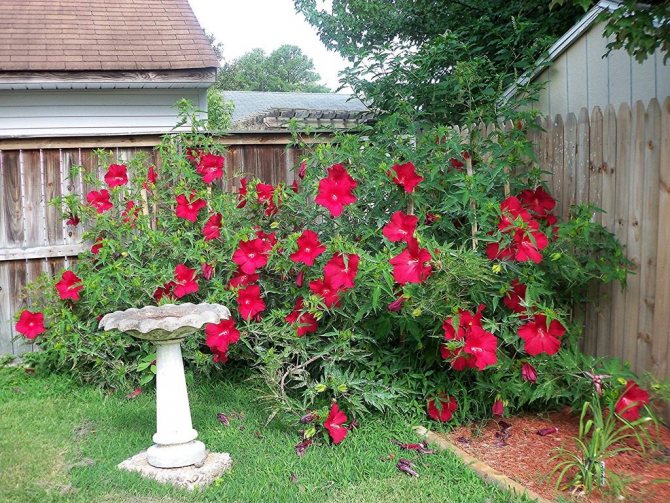

Hibiscus adorns any semi-shaded corner of the yard
Hibiscus adorns any semi-shaded corner of the yard. He is planted:
- in bouquet groups - near roses or other flowering shrubs;
- against the background of a strict coniferous wall;
- as a picturesque hedge when dividing the garden into zones;
- as a bright soloist in a flower bed, especially if formed by a stem.
Why is the Chinese rose considered the flower of death?
The Chinese rose is popularly considered a symbol of death. According to legends, if a plant begins to bloom, then this indicates that someone will die in the house. But this interpretation applies only to those cases when hibiscus blooms unexpectedly - earlier than usual. There are other signs as well.
When the flowers of the Chinese rose wither
Many people believe that if a plant's flowering is associated with trouble, then its wilting becomes a good sign. But this is not the case. If you notice that the Chinese rose has begun to shed its leaves, then this is also not good - this behavior of the flower becomes a signal for the development of a serious illness in someone living in the house.
It is worth noting that the disease often proceeds quietly, without pronounced symptoms. And if you notice that the hibiscus suddenly began to wither, the omen advises you to pay attention to your well-being; it will be far from superfluous to undergo additional examination.
In addition, superstitious people say that when a hibiscus loses its leaves, it does not get enough nourishment. And in order not to weaken, it begins to draw energy from the tenants of the apartment. During this period, the owners may feel weak, tired, unwilling to do anything.
This belief has another interpretation - if a Chinese rose suddenly began to lose leaves - this suggests that it has absorbed all the negativity present in the house, and in this way took the trouble away from the owners.
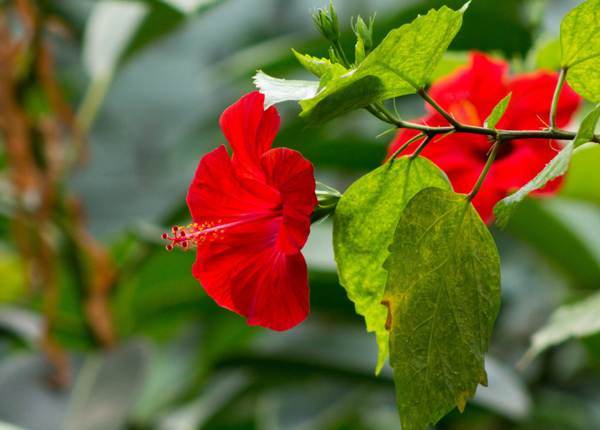

What happens if hibiscus blooms on time?
The flowering of the Chinese rose in the house is associated with signs not only with death. But even when she produces flowers in a timely manner, things to come can be both good and bad.
- For unmarried women, this is a positive sign. According to legends, soon the girl will meet a soul mate.
- If the plant bloomed in the house of a married woman, then this portends disagreements in the family and quarrels. Feelings between spouses will begin to fade, which can lead to separation.
- Other beliefs say that the flowering of the Chinese rose brings happiness to the house. If the spouses have lived together long enough, then old feelings will flare up with renewed vigor. Replenishment in the family is possible. The dying flame of love will ignite again.
Flower Traditions and Benefits of Hibiscus
Hibiscus is not considered the flower of death everywhere, and there are many reasons to put it in your home:
- The Feng Shui teachings say that if you put and care for a hibiscus in the bedroom, which blooms in large bright red or pink flowers, it helps to ignite passionate feelings and the desire to merge into one in a couple in love. These emotions and desires will never go out.
- In Asia, they believe that a Chinese rose with large white inflorescences is suitable for people with serious health problems, it absorbs all negative energy and helps to cure ailments.
- Indian girls from a colorful beautiful flower make wedding wreaths for the bride or weave inflorescences into their hair. The delightful beauty of hibiscus for them is a symbol of purity.
- Inhabitants of the warm islands weave wreaths of blossoming Chinese rose flowers and decorate the garden interior and their homes with them, as well as offer them to tourists as a souvenir of the trip and to create beautiful photographs.
- Large blooming hibiscus flowers are a must for weddings in Southern China.
Can you keep a Chinese rose at home?
As you can see, the signs about this plant are quite contradictory, which makes it quite difficult to determine whether it is possible to keep a Chinese rose at home. Let's consider a few more interpretations that will help clarify the situation.
- The Chinese rose is called not only the flower of death. His other nickname is muzhegon. So he was christened for his ability to bring on the crown of celibacy. Signs say that this plant drives men out of the house in which it grows.
- Hibiscus is able to bring resentment and misunderstanding into the family life of spouses, regardless of whether it blooms or not.
- This plant can affect the personal life of young girls in a negative way. They say that with his appearance in the house, the young lady will not be able to build a strong relationship. Dating is quite possible, but they will not entail anything serious.
- Other signs speak of the positive influence of this flower on personal life. So, a girl who will carefully look after this controversial flower will gain good health and become very attractive to the opposite sex. In this case, the attention of men is guaranteed to her.
- If you still have not decided whether it is possible to keep a Chinese rose in an apartment, then you should pay attention to one more belief. It says that this flower has the ability to charge the atmosphere with a positive and bring energy of movement. This is due to the fact that this plant was born under the sign of Leo (the element of Fire) and is endowed with a strong masculine principle. Therefore, hibiscus loves bright light, from where it draws energy, and shares it with everyone around.
- The Chinese rose becomes a source of creativity. If you take good care of her, she will absorb the energy of laziness and transform it into useful action. Therefore, according to popular beliefs, it is advisable to engage in sluggish passive people who want to change their lives in its cultivation. Hibiscus will actively feed them with energy and provoke new achievements.
It is recommended to keep the Chinese rose in the house if you have low blood pressure or are diagnosed with heart disease.
There are a lot of negative signs about the Chinese rose, as its nicknames eloquently speak. However, at the same time, many plant owners live quite happily and enjoy the beauty every day no matter what.
The main thing is not to pay attention to negative interpretations, because it is thoughts that create our reality. Remember this, and let nothing stop you from enjoying life to the fullest.
Flowers for growing at home
Indoor flowers create coziness and beauty in the room. Each plant has its own positive and negative qualities that affect human health and mood. All plants in the house enrich the air with oxygen, create a beautiful interior and serve as an excellent humidifier.
Each flower has its own energy. The most suitable plants for the home instead of hibiscus:
- Hyacinth - fills the household with love, joy and the desire to move only forward.
- Lemon invigorates and helps to overcome various diseases and phobias.
- Violets bring aesthetic pleasure and improve mood.
- Cyclamen restores inner harmony in a person and adjusts to positive emotions.
- Anthurium helps to overcome shyness and stiffness.
- Indoor spruce is an excellent solution for a creative person, it can enhance his activity.
- The tree fat woman is suitable for people who want to improve their financial condition.
You should not pay attention and believe in all the signs. They are able to drive a person crazy. The hibiscus flower has many positive properties, which contradicts the well-established opinion about it as a harbinger of misfortune.
The Chinese rose, or hibiscus, has received a not very pleasant nickname among the people. This plant is called the flower of death, and superstitious people attribute various mystical properties to it.But he does not always bring trouble to the house - some signs about the Chinese rose have a positive interpretation and portend a favorable turn of fate.
What are the signs and superstitions associated with hibiscus?
It is surprising that a lot of omens and superstitions are attributed to the Sudanese rose, and all of them are negative in color. The most common:
- Hibiscus is given the name "muzhegon", as there is an opinion that the presence of a plant at home can lead to the departure of a man from the family. However, there is no evidence of this superstition, many families are happy, while on the window you can see a blooming Sudanese rose.
- When blooming, hibiscus releases negative energy, so scandals, illnesses, even the death of a household member begin.
- If a flower blossomed in winter, or in early spring, which is the most inappropriate period for it, it was interpreted as a mortal danger, then they expected the possible death of one of the relatives.
- Blackening of leaves, falling of unopened buds also belonged to the signs that bring death to one of the owners of the Chinese rose.
Superstitious people refuse to purchase an exotic tree, but there are many more who do not believe in omens.
Important! No superstition or omen associated with hibiscus finds any confirmation.
Attitude to the flower in different countries


0
A source:
Despite the skepticism and contemptuous nickname - muzhegon, in India, hibiscus, on the contrary, is considered a plant that strengthens marriage, and is used during wedding ceremonies as an element of jewelry - wreaths and garlands that future spouses exchange. In Malaysia, there is generally a kind of hibiscus cult. His image is even present on the state emblem. And in the country there is a whole park of such roses, the number of bushes in which exceeds 2000 copies. It is often used for weddings.


0
The Chinese rose is also popular in Argentina: in this country, in almost every house or office building there is at least a couple of hibiscus pots, and their absence even causes sincere bewilderment among guests and visitors. The local population associates bright red inflorescences with the kindness of a person and the purity of his soul. Hibiscus is an integral part of the local flavor in Haiti and Hawaii. The curls of the local girls meeting tourists are always decorated with at least one hibiscus bud. And the garland worn around the neck of the guests, in which roses are also woven, symbolizes openness and expresses hospitality.
The magical properties of the plant
Many signs say that the Chinese rose is a source of negative energy that brings death. Superstitious people are convinced that hibiscus is able to warn its owners of impending troubles.
If all the leaves of the plant have fallen off, one of the family members will soon become very sick.
The hibiscus is featured on the Malaysian coat of arms. The people of Southeast Asia appreciate this flower very much. There is a park in Kuala Lumpur where you can see more than 2000 varieties of tropical roses.
Currently browsing → Signs and superstitions about the Dieffenbachia flower
According to Feng Shui, hibiscus affects the Chi energy, which is responsible for health. Ancient Chinese science recommends getting red sorrel for hot-tempered people so that the home atmosphere is calmer and warmer. White okra can enhance passion.
Is it possible to keep hibiscus at home, and should you pay attention to the signs
Signs and myths are just assumptions. Believe in them or not, everyone decides for himself, but having acquired hibiscus, you can notice some changes: health improves, and life becomes brighter and more diverse.
Chinese rose in the house, signs:
- improves marriage and strengthens family relationships.Therefore, it is better to keep the flower in the bedroom, where it will resume the fading light in the relationship;
- hibiscus will not only give comfort and coziness, but also cleanse and heal the atmosphere in the house;
- the plant increases energy and gives confidence to shy people.
The location of the flower in the apartment is also important. The whole house, according to the teachings of Feng Shui, is divided into zones that are responsible for their element. Hibiscus, depending on the color, carries different elements:
- Yellow flowers - the element of the Earth, it is better to grow them on the southeast side.
- White - the element of Metal. Locations - western windows. According to Feng Shui, white is the color of purity and divine love, it fills the atmosphere with energetic freshness.
- Red - the element of Fire, grown on the south side of the house. Red flowers charge the house with energy, give a burst of energy and a positive attitude towards life. Hibiscus with red flowers is an indispensable helper for insecure and slow people.
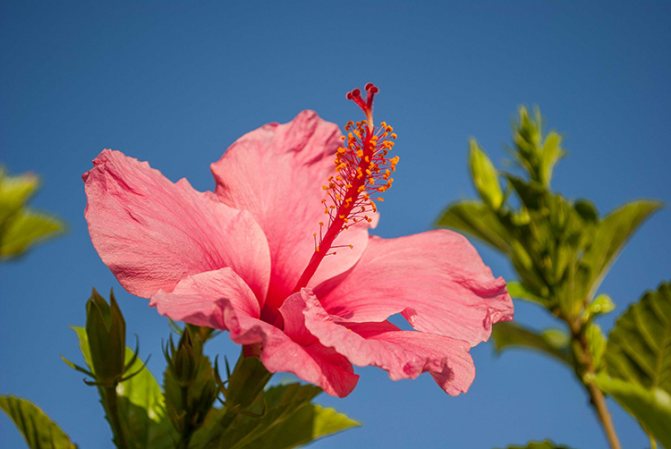

What good people say about hibiscus
In addition to the negative, many good things are said about hibiscus. It's not for nothing that the flower is called the Chinese, as well as the tea rose:
- the flowers of this plant are a popular decoration for the hairstyles of women living in Malaysia and Hawaii;


On the islands of the Pacific Ocean, women adorn their hairstyles with hibiscus flowers, which may be why one of its local names translates as "the flower of beautiful ladies" - even the pharaohs of Ancient Egypt enjoyed a pleasant sour hibiscus tea brewed from hibiscus flower cups;
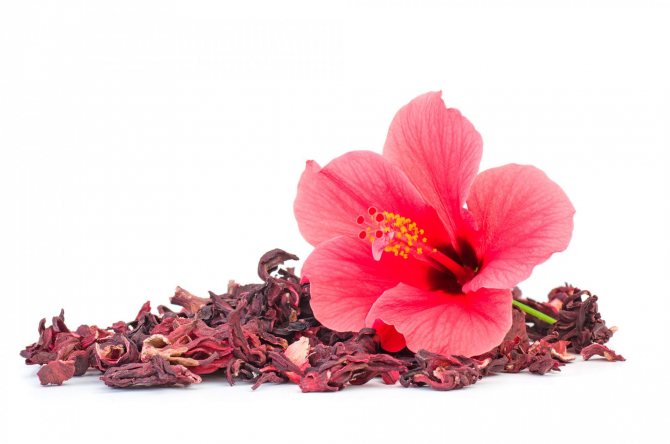

The dried cups of hibiscus flowers are called hibiscus and are widely used as an aromatic additive in the food industry and herbal medicine. - medical research confirms that the plant produces phytoncides that kill and inhibit the growth and development of pathogenic bacteria;
- Astromedicine recommends growing hibiscus for people with cardiac problems, as it stimulates the heart.
Believing negative beliefs or seeing positive in hibiscus is entirely up to you. If you are not a superstitious person, then hibiscus will definitely become a chic decoration for your home. Most importantly, do not forget about the rules for caring for the plant.
How to avoid negative predictions
The fashion for the maintenance of hibiscus appeared during the Soviet era and has survived to this day. The popularity of the plant is explained by its attractiveness and unpretentiousness. Mallow blooms beautifully, purifies the air, does not cause allergies.
To mitigate the possible negative impact, you need to move the plant to where people are for a short time. It could be a corridor or a hallway. Especially superstitious people who believe that the Chinese rose attracts misfortune or death, esotericists recommend getting rid of it. The tree must be taken out into the yard and then burned to the ground.
The sign of hibiscus at home can have both positive and negative meanings. Many people who have an exotic plant at home live a happy life despite superstition. Negative signs about a plant can only harm those who believe in them.
The end of the white streak in life begins with the dying of the hibiscus
Another superstition related to why the Chinese rose is the flower of death. Perhaps this is due to the fact that the transience of flowering provokes the appearance of sad thoughts about the natural wilting of the beauty of any living creature.
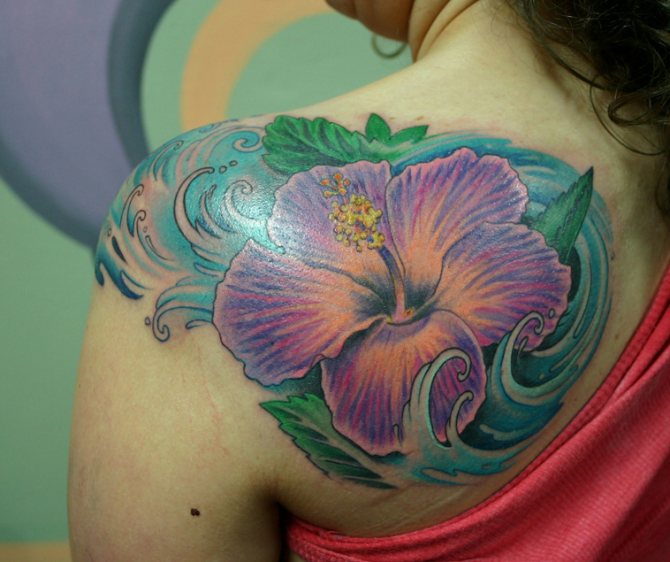

But it is worth remembering that this is the same biological process that occurs according to its own rules. One bud of an ordinary hibiscus blooms normally no longer than one day. Fortunately, others come to replace it, and several flowers appear in an adult plant at the same time. And with the right conditions, hibiscus will bloom constantly.
Fallen leaves - to a serious illness
Another sign, explaining why the Chinese rose is the flower of death, tells that the discarded leaves portend a serious illness or misfortune.It is not possible to refute or confirm this sign, since it was formed many generations ago. According to legend, without leaves, hibiscus does not receive the necessary energy and draws it from the people living next to it. At the same time, there is an opposite opinion, which is that a withering plant takes over the diseases of family members, thereby protecting them.
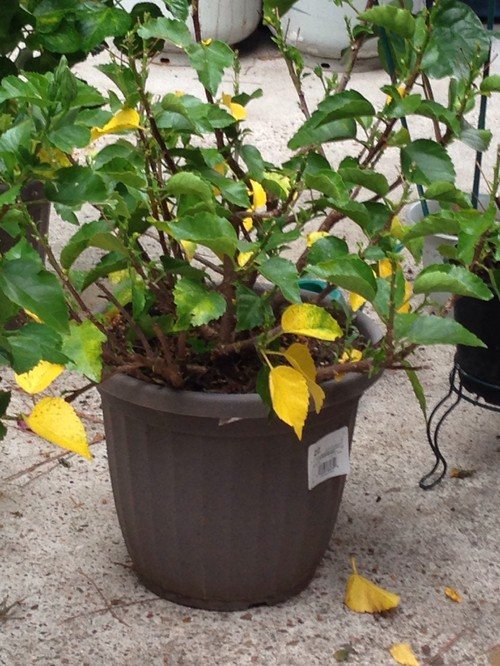

In any case, all evergreens gradually renew their green mass by getting rid of the leaves. There is nothing scary about this. Although if the growing leaves begin to acquire a yellow or black color, then this is an alarm signal. It is necessary to examine the hibiscus for the presence of pests and, if necessary, take measures to treat it.
Any process can be explained from a scientific point of view, so do not torment yourself with beliefs and omens. But if you are very tormented by forebodings and suspicions, then it is better to consult a doctor in order to either calm yourself down or prevent a terrible disease.
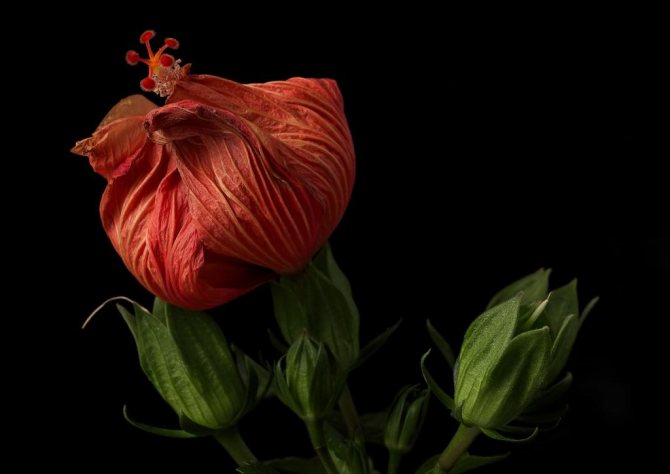

Street hibiscus: does it bring death
The Chinese, Sudanese rose is grown in gardens and on the streets of an area with a very warm, tropical climate. Those who believe in superstitions, omens, are sure that a street plant also brings death to the owners of those dwellings near which this shrub grows.
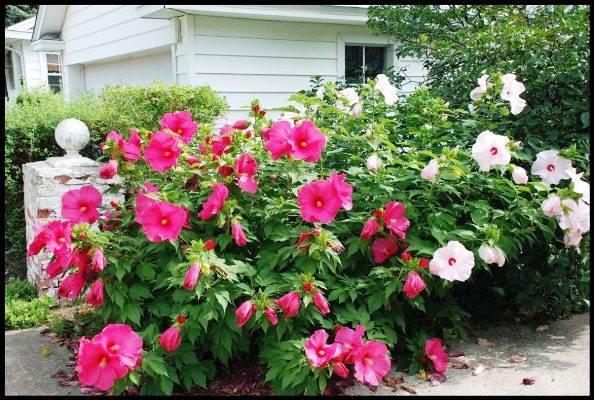

Many believe that the portents related to indoor hibiscus also have a negative effect on the cultivation of the Chinese rose in gardens, front gardens and outdoors. In addition to the fact that the Chinese rose "pulls" the energy of the owner of the garden, it is rumored to be endowed with the ability to shorten the life of its owner. This statement is not substantiated by anything, there is no point in believing it.
Hibiscus care rules
Hibiscus needs light and will shed leaves in the shade. But direct sunlight is harmful to the leaves, yellowish spots will appear - burns. It is better to put the pot on the southern or eastern windowsill, covering the window with tulle to diffuse the sun's rays.
Watering should be sufficient, but not excessive. Dry land should not be allowed, but water should not stand. If the top layer is dry by about three centimeters, it's time to water. The ideal option is to use drip irrigation.
Hibiscus loves moisture, so you need to spray the plant periodically. It is better to do this in the morning so that excess water evaporates during the day. To moisturize, you can place glasses of water around the flower.
Like any plant, the Chinese rose needs fertilization. Feed the flower a couple of times a month. This is especially important during the period of bud formation and flowering.
In order for the flower to grow more magnificently, pruning must be carried out in the spring. Be sure to remove dried and exposed branches. And cut healthy ones in half. Pruned healthy cuttings can be used for propagation.
Is it worth growing on a window or not?
Today, the Chinese rose is widely used in horticulture. New varieties of this ornamental plant have been developed with flowers of different shades and sizes (for example, the Angel Wings variety is often used as a garden decoration). Hibiscus does not withstand too low and too high temperatures, so in Russia it is ideal as a houseplant. With proper care, the Chinese rose can grow beautifully even on northern windows.... The optimum temperature for growing a Chinese rose: in summer - 22 degrees, in winter - 15 degrees.
How poisonous is the flower?
Not everyone knows that "karkade" or red tea is nothing more than brewed Chinese rose petals. The plant has a number of medicinal properties. However, tea made from Chinese rose flowers is not recommended for people with high acidity of the stomach, gastritis. This contributes to the development of ulcers.
Important! Expectant mothers should also give up the use of karkade. Tea increases the tone of the uterus, which can cause premature birth and various complications.
How does hibiscus affect the human body?
Since ancient times, the Chinese rose has been used to treat many diseases and has a positive effect on overall health.
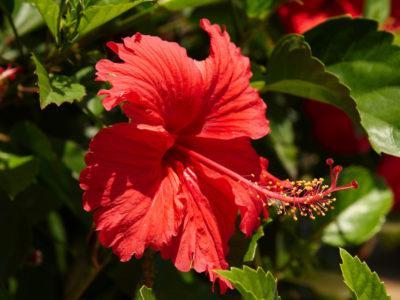

General strengthening of the immune system.- Anthelmintic effect and prevention of helminths.
- Normalization of blood pressure indicators.
- Antispasmodic action.
- Anti-inflammatory effect.
- Removal of toxins and toxins from the body.
- Hemostatic action.
- Anticonvulsant and bactericidal action.
- Antioxidant effect.
Plant in the interior: winning design options
In terms of floriculture, it is a pleasure to grow hibiscus at home.... This plant, with proper care, grows into a beautiful tree with amazing flowers. They do not last long - about 2 days, but new buds appear quite often.
So that households can always enjoy a beautiful and healthy plant, you need to choose a bright and spacious place in the apartment for it in advance. The best option is on the floor in the corner of the room. Hibiscus will green any room, it will perfectly fit into any interior and decorate it. Another option is to put the pot on a warmed loggia, creating an imitation of a winter garden.
Why can't it sometimes be bred at home?
Hibiscus also has several disadvantages. The plant can grow quite impressive for an ordinary apartment - up to 3 meters. Also, the stalk of a Chinese rose is quite expensive compared to other indoor flowers and is very often exposed to pests.
You can not keep hibiscus at home with allergies or individual flower intolerance. It is also not recommended to place the plant in homes where there are animals or small children. Generally the plant is not poisonous, and the decision on whether to grow and propagate it or not is made by the person himself.
Today, the Chinese rose, despite its beauty, can be found mainly in office and administrative buildings. I would like to believe that the bad fame about this beautiful plant will dissipate, and it will be possible to see it in the apartment of every grower.
Why hibiscus is called the flower of death: reviews of real people
lion4ik-li, Krasnodar:
“Advantages: it blooms beautifully, unpretentious.
Disadvantages: no.
My love for this lovely, but at the same time unpretentious plant has been going on for quite some time. We have always developed a relationship of complete mutual understanding with hibiscus, so it delighted my eyes with bright, luxurious, voluminous flowers almost ... ".
Read full review https://enn.imadeself.com/review_3726487.html.
Much Happiness, Severodvinsk:
“Advantages: very beautiful.
Disadvantages: a large bush, it will be inappropriate in a small apartment.
This flower has been growing for me for the fourth year already. According to the old tradition, its sprout was carefully stolen from the guests. It took root very quickly, but began to bloom only in the second year. The flower is about a meter high and ... ”.
Read full review https://enn.imadeself.com/review_3568715.html.
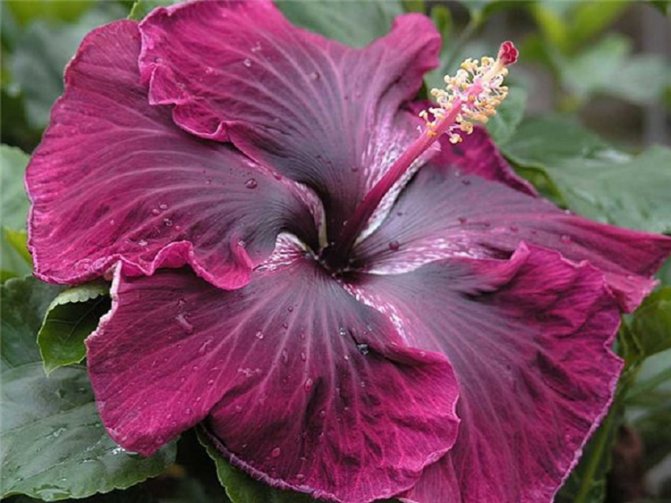

Hibiscus is a harbinger of love and a source of energy
This flower is used as a wedding decoration in India.
It contributes to the preservation of passion in spouses, if identified in the bedroom. Hibiscus is recommended to start in order to revive love relationships, which have become a victim of everyday life.
The Chinese rose gives a girl beauty and helps her to attract attention from the male sex.
In addition to the countries of the eastern part of Europe, where frightening magical properties are attributed to hibiscus, it is recognized throughout the world as a symbol of love and passion in relationships.
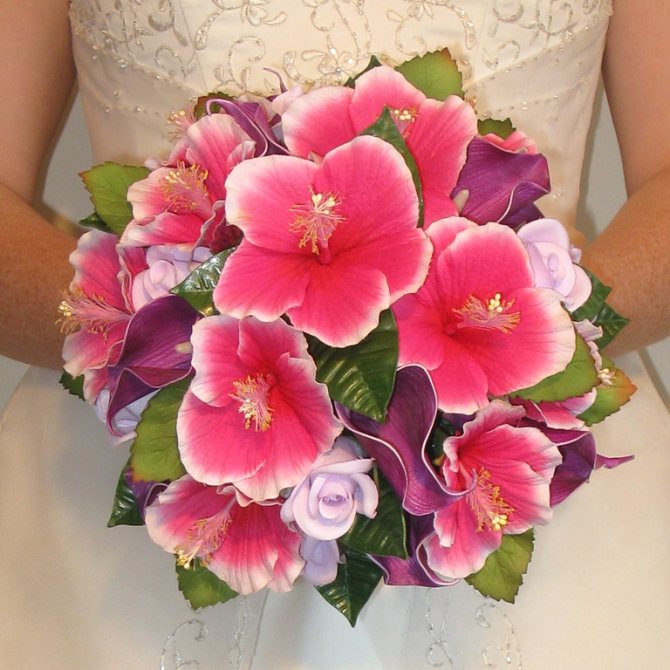

From the dried flowers of the Chinese rose, infusions have long been prepared, designed to restore and maintain a woman's health, improve complexion, skin and hair condition. Fresh buds are used as an ingredient in cosmetics and perfumes.
The flower is also credited with the ability to turn laziness into creativity and have a beneficial effect on the atmosphere, charging it with a special energy of movement.
According to the Chinese horoscope, hibiscus is a plant of people born under the sign of Leo, which additionally gives it a masculine principle and pronounced activity.
Interesting Facts
- Young foliage and shoots in some countries are used for cooking, medicines are made from seeds and rhizomes, and hair dye, food coloring and hibiscus tea are made from flowers.
- In South Korea, Syrian hibiscus is grown in every home, as they consider it their own plant and believe that it brings happiness and love to the family.
- In Congo and Cameroon, the sour hibiscus variety is sold in bazaars as the main ingredient in salads. In Brazil, this variety replaces spinach due to its high content of carotene, ascorbic acid and B vitamins.
- In Hawaii, the Chinese rose is called the "flower of beautiful women" and is considered a national treasure.
- Okra, or the edible rose, was known in Egypt as early as 1216. The green seed pods were used to prepare wonderful dishes.
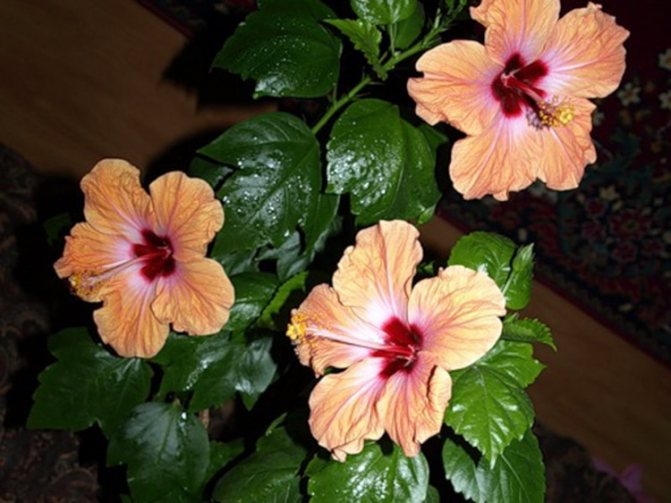

Attitude towards hibiscus in Europe, signs associated with it
All the bad omens associated with this flower originate from Europe and China. It is these countries that attribute to him the ability to bring misfortune, grief, disease. In many European countries, there is an opinion that a potion is being prepared from a Chinese rose, which is used by witches to create a celibacy wreath.
The flower is called a burnet, it is believed to have the ability to aggravate blood diseases. Many people see a shade of blood in a bright red color, but the flower looks more like a flame with its bright red hue. According to rumors, almost all witches use this specimen for their black deeds. He is credited with the properties to quarrel spouses, bring a person to depression, even to the grave.
It is believed that a lonely girl who decided to settle this wonderful plant with red large inflorescences in her apartment will soon become popular with representatives of the opposite sex, but there will be no permanent relationship while the flower is in her home.
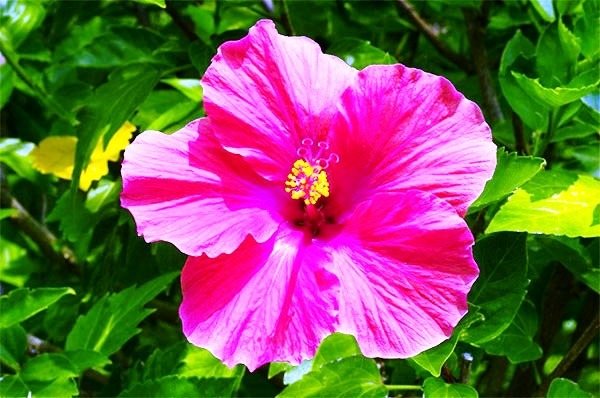

The popularity of the Sudanese rose in hospitals, where it grows and blooms very luxuriantly, is explained by the fact that the shrub feeds on negative emotions, the pain of people, and increases mortality. This opinion is not due to anything.
What does hibiscus look like, where does it grow?
A tall shrub with shiny dark green toothed leaves is planted in gardens and apartments. It is divided into perennial and annual specimens. Low-growing annual seedlings are sown in early spring; from the beginning of summer, abundant flowering continues until the end of autumn. Annuals are intended for cultivation in the garden in the country, for apartments you need to choose perennial specimens.
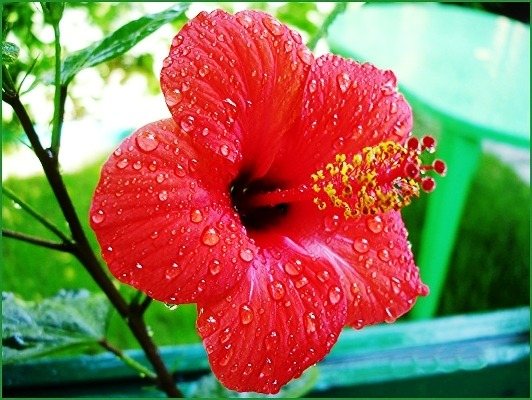

Some craftsmen transform the hibiscus into an exotic bonsai, a small tree with a dense trunk, a pair of leaves, on which only one flower blooms. Once formed by a standard tree, it can survive for up to 15 years. Such a tree has a high cost.
Important! Hibiscus can grow anywhere, special conditions are not required for it.
Timely pruning and transplanting will help create a beautiful standard tree that can delight with large bright flowers from early summer to late autumn. Indoor Sudanese rose perfectly coexists with other flowers, due to the fact that it has the property of emitting phytoncides, nearby plants are less likely to be affected by pathogenic bacteria.
Is everything so bad
But such a bad attitude towards the flower developed only in the countries of Eastern Europe. All over the world he is loved and revered, and the Fiji island even hosts an annual festival dedicated to this beautiful plant.
If you turn to Feng Shui, you can find out that hibiscus returns the passion between spouses, lost over the years, and also strengthens family relationships. The couple fall in love with each other again, like a honeymoon.
In addition, hibiscus helps to get rid of many health problems:
- Tea with plant leaves reduces high blood pressure and has a beneficial effect on the state of the cardiovascular system. Hibiscus rosella tea is a drink made from rosella flowers of the genus Hibiscus.
- The drink normalizes the functioning of the nervous system.
- Helps with insomnia.
- Heals wounds. Pounded flowers are applied to the affected areas.
And in the room where there is a Chinese rose, the air is always clean. After all, it secretes phytoncides that destroy pathogenic bacteria.
Is it possible to plant hibiscus in the garden
Hibiscus came to us from afar, and our climate is not very suitable for him. But, thanks to breeders, varieties were bred that are suitable for our latitudes. These specimens do not exceed three meters in height and can withstand frosts up to 30 degrees.
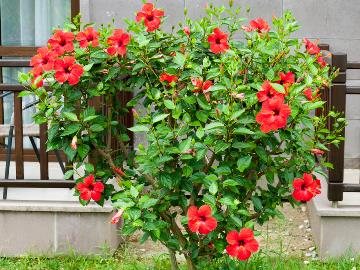

Of course, in order to survive the winter, the plant will need to be helped - either to cover it well, or to bring it into the house - after all, a rare winter in Russia does without a temperature drop below thirty degrees.
There are several types of hibiscus that we can grow, but the principle of care is the same for everyone. First, you need to choose a suitable location. The plant must be protected from bright sun. There should also be no threat of strong winds. Secondly, the soil should be rather loose and nutritious. Timely watering is necessary as the land dries up.
Different species have their own characteristics of care. And a kind of pruning, and weeding, and mulching. But warming for the winter is required for any kind, so do not forget to try in the fall.
The Chinese rose can be grown from seeds and cuttings. Seeds are best sown in the middle of winter. Do not forget to spray future bushes in a timely manner. It can be planted in open ground only when the threat of frost has passed.
When grafting, you need to remove almost all the leaves from the shoot and put it in water. When fairly long roots appear, you can plant the hibiscus in a pot of peat, from where you can transplant the bush into open ground when the plant gets stronger.
And do not forget, young plants do not tolerate frosts so well, therefore, in the first year, measures for insulation will have to be thought out especially carefully.

